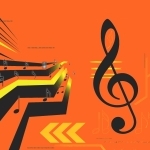
 |
Jukebox |
Children love music. They can sing along, dance and jiggle, tap their feet, hum, sway and simply listen to the many types of music around us. Music allows freedom of expression and creativity, but most of all encourages children to have fun.
We have designed this great activity for children to explore their musical side. It is also a great teaching resource in the room as it can be used to support other group activities.
The screen has three main areas. Play list, selection area and right side toolbar.
The play list shows twenty-four pictures, each representing a different song. More choices can be found by clicking the green arrows above and below the play list.
Icons are present in the lower right corner of the pictures to help with the selection process. Songs are grouped into four main categories.
| Dance | |
| Relaxation | |
| Songs/Music for sing-along | |
| Orchestral | |
| Instrumental |
The longer musical pieces have a time indicator included on the picture.
At the bottom of the screen is the selection area. Songs can be dragged into and out of this area. Their order can also be rearranged at any time. Clicking on the red X to the left of this area will remove all the selected songs.
To play the selected songs, click on the green forward arrow button at the bottom of the toolbar. Each song will now play in a continuous loop in the chosen order. The toolbar now has a green backward arrow button, which will take you back to the first selection screen. Below this is a gold coloured pause button.
Volume is controlled on either screen via the slider on the toolbar. Click where you want the slider to be placed or click and drag it into place. If you are using touch screen technology the first method is recommended.
Note that the volume is also affected by the system volume settings. You may also need to adjust the volume up or down using the computer's volume buttons.
To exit, click on the small hand at the top of the toolbar.
Outcome 1: Children have a strong sense of identity
Outcome 2: Children are connected with and contribute to their world
Outcome 4: Children are involved and confident learners
Outcome 5: Children are effective communicators
Musical appreciation
Creativity
Listening
Memory
Recognition and use of computer icons
Decision-making
Toolbar use
Navigation
Children will have lots of fun with this activity. They will listen to different songs and enjoy moving them around to create different play lists.
The word "icon" has a few different meanings. For IT purposes it can be defined as a small pictogram on a computer display representing an instruction or option. A pictogram is a simple, pictorial, representational symbol. Icons make computers use easier and have been in use since the 1970's.
In our Jukebox activity we use icons to indicate a grouping of the musical pieces. This makes selection easier as it gives an idea of content without requiring written titles.
Partially fill empty plastic containers with different materials such as rice, sand, coins, marbles or dried pasta. Seal the lid with adhesive tape. Paste some paper around the outside and have fun decorating your musical instrument.
soundjay.com
musicalrelaxation.com
partnersinrhyme.com
kidsmusicweb.com